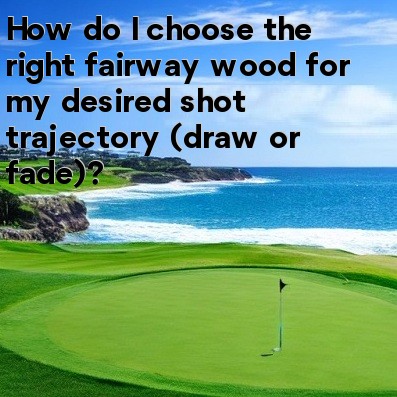
Choosing the Right Fairway Wood for Your Desired Shot Trajectory
When it comes to selecting the right fairway wood for your desired shot trajectory, there are a few key factors to consider. One of the most important elements is understanding the difference between a draw and a fade shot. Here, we will delve into the various aspects you should consider when making your selection.
Shot Trajectory: Draw vs. Fade
A draw shot is the curved flight path of a golf shot that moves from right to left for a right-handed golfer (and left to right for a left-handed golfer). This shot typically offers more distance, as the clubface closes at impact, imparting additional spin on the ball.
On the other hand, a fade shot is characterized by a flight path that moves from left to right for a right-handed golfer (and right to left for a left-handed golfer). The fade shot often provides better accuracy and control, as the clubface opens at impact, reducing spin on the ball.
Club Selection for Draw and Fade Shots
When choosing a fairway wood for your desired shot trajectory, keep the following considerations in mind:
1. Clubhead Design
The design of the clubhead plays a critical role in shot trajectory. To hit a draw, look for a fairway wood with a slightly closed clubface angle at address. Conversely, for a fade, opt for a fairway wood with an open clubface angle.
2. Shaft Flexibility
Shaft stiffness affects the club's behavior during the swing and impact. For a draw shot, a more flexible shaft can help promote a slight closing of the clubface. Conversely, for a fade shot, a stiffer shaft can assist in holding the clubface open at impact.
3. Loft Angle
The loft angle of the fairway wood also plays a role in shot trajectory. A higher lofted club will generally promote a higher ball flight, which can help enhance a fade shot. In contrast, a lower lofted club may help achieve lower ball flight for a draw shot.
4. Practicing with Different Clubs
To determine the ideal fairway wood for your desired shot trajectory, take the time to practice with different clubs and observe their ball flights. Experimenting with several fairway woods will help you identify the one that best suits your swing and desired shot shape.
Final Thoughts
Choosing the right fairway wood for your desired shot trajectory requires careful consideration of clubhead design, shaft flexibility, loft angle, and some practical experimentation. Ultimately, it's crucial to remember that individual swing characteristics can vary, so what works for one golfer may not work for another. Experimentation and practice are key to finding the fairway wood that allows you to consistently execute your preferred shot shape.
By understanding the differences between a draw and a fade shot, along with the factors that influence shot trajectory, you can make an informed decision when selecting a fairway wood for your golf game.





